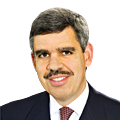
When I consider the prospects for the global economy and markets, I am taken aback by the extent to which the world has collectively placed a huge bet on three fundamental outcomes: a shift toward materially higher and more inclusive global growth, the avoidance of policy mistakes, and the prevention of market accidents. Though all three outcomes are undoubtedly desirable, the unfortunate reality is that they are far from certain – and bets on them without some hedging could prove exceedingly risky for current and future generations.
The first component of the bet – more inclusive global growth – anticipates continued economic recovery in the US, with a three percent growth rate this year bolstered by robust wage growth. It also assumes China’s annual growth rate will stabilise at 6.5 (to seven percent), thereby enabling the risks posed by pockets of excessive leverage in the shadow-banking system to be gradually defused, even as the economy’s growth engines continue to shift from exports and public capital spending toward domestic consumption and private investment.
Another, more uncertain assumption underpinning the bet on more inclusive growth is that the eurozone and Japan will be able to escape the mire of low growth and avoid deflation, which, by impelling households and businesses to postpone purchasing decisions, would undermine already weak economic performance. Finally, the bet assumes that oil-exporting countries like Nigeria, Venezuela, and especially Russia will fend off economic implosion, even as global oil prices plummet.
6.5%
China’s annual growth rate
Guessing game
These are bold assumptions – not least because achieving these outcomes would require considerable economic reinvention, extending far beyond rebalancing aggregate demand and eliminating pockets of excessive indebtedness. While the US and China are significantly better placed than others, most of these economies – in particular, the struggling eurozone countries, Japan, and some emerging markets – would have to nurture entirely new growth engines. The eurozone would also have to deepen integration.
That adds up to a tough reform agenda – made all the more challenging by adjustment fatigue, increasingly fragmented domestic politics, and rising geopolitical tensions. In this context, a determined shift toward markedly higher and more inclusive global growth is far from guaranteed.
The second component of the collective bet – the avoidance of policy mistakes – is similarly tenuous. The fundamental assumption here is that the untested, unconventional policies adopted by central banks, particularly in advanced countries, to repress financial volatility and maintain economic stability, will buy enough time for governments to design and deliver a more suitable and comprehensive policy response.
Higher stakes
This experimental approach by central banks has involved the conscious decoupling of financial-asset prices from their fundamentals. The hope has been that more buoyant market valuations would boost consumption (via the ‘wealth effect’, whereby asset-owning households feel wealthier and thus more inclined to spend) and investment (via ‘animal spirits’, which bolster entrepreneurs’ willingness to invest in new plants, equipment, and hiring).
The problem is that the current economic and policy configuration in the developed world entails an unusual amount of ‘divergence.’ With policy adjustments failing to keep pace with shifts on the ground, an appreciating dollar has assumed the role of shock absorber.
But history has shown that such sharp currency moves can, by themselves, cause economic and financial instability.
The final element of the world’s collective bet is rooted in the belief that excessive market risk-taking has been tamed. But a protracted period of policy-induced volatility repression has convinced investors that, with central banks on their side, they are safe – a belief that has led to considerable risk-positioning in some segments of finance.
With intermediaries becoming reluctant to take on securities that are undesirable to hold during periods of financial instability, market corrections can compound sudden and dramatic price shifts, disrupting the orderly functioning of financial systems.
So far, central banks have been willing and able to ensure that these periods are temporary and reversible. But their capacity to continue to do so is limited – especially as excessive faith in monetary policy fuels leveraged market positioning.
Balancing the odds
The fact is that central banks do not have the tools to deliver rapid, sustainable, and inclusive growth on their own. The best they can do is extend the bridge; it is up to other economic policymakers to provide an anchoring destination. A bridge to nowhere can go only so far before it collapses.
The nature of financial risks has morphed and migrated in recent years; problems caused by irresponsible banks and threats to the payment and settlement systems have been supplanted by those caused by risk-taking among non-bank institutions. With the regulatory system failing to evolve accordingly, the potential effectiveness of some macro-prudential policies has been undermined.
None of this is to say that the outlook for markets and the global economy is necessarily dire; on the contrary, there are notable upside risks that could translate into considerable and durable gains. But understanding the world’s collective bet does underscore the need for more responsive and comprehensive policymaking. Otherwise, economic outcomes will remain, as former US Federal Reserve Chairman Ben Bernanke put it in 2010, “unusually uncertain”.
Mohamed A. El-Erian is Chief Economic Adviser at Allianz and Chairman of President Barack Obama’s Global Development Council.
© Project Syndicate, 2015


